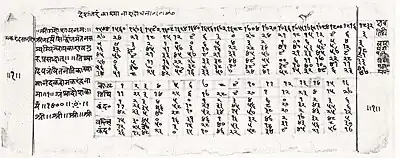
Makarandasāriṇi is a Sanskrit astronomical table text composed by the Indian astronomer-mathematician Makaranda (c.1438-1478) hailing from Varanasi. In the Sanskrit astronomical literature such table texts are referred to as sāriṇi-s or koṣṭhaka-s. (The word sāriṇi may be loosely translated as “stream, path, line”.) It is one of the most popular such texts ever composed in Sanskrit.[1]
Important features
Makarandasāriṇi follows the Saurapakṣa. This is the midnight-epoch system embodied in a recension of the Sūryasiddhānta dating to around the eighth century.[1] This is reflected in the choices of the values of the fundamental parameters, like the values of the celestial bodies’ revolution-numbers and consequent mean velocities. Another unique feature of Makarandasāriṇi is the use of vegetation-themed Sanskrit technical terms for its various tables. The table giving the mean position increments has been called vāṭikā (garden) and the table giving calendar day/time for mean time unit has been called guccha (blossom, flower). There are tables named valli-s (creeper) and saurabhaṃ-s (fragrance, perfume). In comparison to most other sāriṇi-s or koṣṭhakā-s, Makarandasāriṇi has no accompanying set of verses except for an invocatory stanza at the beginning of the text.[1]
Contents
Among other things, the book has tables relating to the following:[2]
- the ending moments of tithi, and yoga
- the mean longitudes of the Sun, the Moon and the five tārāgraha-s viz, Kuja (Mars), Budha (Mercury), Guru (Jupiter), Śukra (Venus) and Śani (Saturn),
- the mandaphala (equation of the centre) of each of the heavenly bodies,
- the equation of the conjunction of the five planets,
- the moments of solar ingress (saṅkarmaṅa) into the rāśi-s (zodiacal signs) and nakṣatra-s (the twenty-seven asterisms)
- the Sun’s declination (krānti)
- the latitude (śara, 'vikṣepa) of the Moon
- the angular diameters (bimba) of the Sun, the Moon and the earth’s shadow-cone (bhūcchāyā, bhūrbhā) for computing lunar and solar eclipses.
Commentaries
There are a large number of commentaries on Makarandasāriṇi in circulation. These commentaries provide detailed instructions on how to use the tables sometimes with elaborate worked examples. The following is only a partial list of these commentaries.[1]
- Makarandapañcāṅgopapatti of Ḍhuṇḍhirāja (fl. 1590)
- Makarandavivaraṇa of Divākara (b. 1606)
- Makarandapaddhatikārikā of Harikarṇa (fl. 1610)
- Abhinavatāmarasa of Purus.ottama Bhaṭṭa (fl. ca. 1610)
- Makarandodāharaṇa of Viśvaātha (fl. 1612/1630)
- Makarandaṭippaṇa of Moreśvara (1622 CE)
- Subodhikā of Kṣemaṅkara Miśra (fl. 1632)
- Makarandakārikā of Kṛpārāma Miśra (fl. 1815)
- vāsanā of Nīlāmbara Jhā (b. 18 July 1823)
- udāharaṇa of Jīvanātha Jhā (fl. ca. 1846/1900)
See also
Additional reading
- Clemency Montelle and Kim Plofker (2018). Sanskrit Astronomical Tables. Springer. ISBN 978-3-319-97036-3. Retrieved 20 December 2023.
- David Pingree (1973). Sanskrit Astronomical Tables In England. Madras (Chennai): The Kuppuswami Sastri Research Institute. Retrieved 20 December 2023.
- Vishnunath (1923). Makaranda Sarini. Retrieved 20 December 2023. (Name of publisher not mentioned. Digitized from Digital Library of India.)
- Balachandra Rao S, Rupa K and Padmaja Venugopal (2013). "An analysis of the mandaphala tables of Makaranda and revision of parameters" (PDF). Ganita Bharati. 35 (1). Retrieved 20 December 2023.
References
- 1 2 3 4 Clemency Montelle and Kim Plofker. Sanskrit Astronomical Tables. 2018: Springer. ISBN 978-3-319-97036-3.
{{cite book}}: CS1 maint: location (link) - ↑ K. Rupa, Padmaja Venugopal and S. Balachandra Rao (2014). "Makarandasarini and allied Saurapaksa tables: A Study" (PDF). Indian Journal of History of Science. 49 (2): 186–208. Retrieved 20 December 2023.